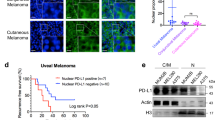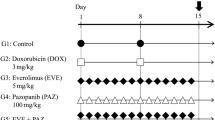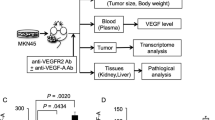Abstract
Melanoma tumor growth and progression are highly dependent on adequate blood supply through angiogenesis. Since several genes involved in angiogenesis revealed potential binding sites for the transcription factor Sp1, we have examined the effects of local inoculation of Sp1 decoy oligodeoxynucleotides (ODNs) on the growth of transplanted murine melanoma tumors and the expression of VEGF and TNF-α within these tumors. Treatment with Sp1 decoy ODNs, but not their mutated form, led to a significant increase (P=0.041) of the tumor necrotic area, as evaluated morphometrically. Tumor necrosis was associated with a significant decrease of microvascular density (P=0.012) and relative vascular area (P=0.026), as determined by counting CD34-positive vascular structures within the tumor microenvironment of Sp1 decoy ODNs and control ODN-treated tumors. RT-PCR experiments showed a strong decrease in the levels of VEGF188 and VEGF164 isoforms and a moderate decrease of TNF-α in Sp1 decoy-treated tumors. Taken together, our results indicate that Sp1 decoy ODNs may inhibit angiogenesis by affecting the gene expression of key players in angiogenesis such as TNF-α and VEGF. These findings indicate that Sp1 decoy ODNs may be a potential new therapeutic tool in antiangiogenic therapy.
This is a preview of subscription content, access via your institution
Access options
Subscribe to this journal
Receive 12 print issues and online access
$259.00 per year
only $21.58 per issue
Buy this article
- Purchase on Springer Link
- Instant access to full article PDF
Prices may be subject to local taxes which are calculated during checkout



Similar content being viewed by others
References
Folkman J, Klagsburn M . Angiogenic factors. Science 1987; 235: 442–447.
Fidler IJ, Ellis LM . The implications of angiogenesis for the biology and therapy of cancer metastasis. Cell 1994; 70: 185–188.
Hanahan D, Folkman J . Pattern and emerging mechanisms of the angiogenic switch during tumorigenesis. Cell 1996; 86: 353–364.
Pober JS et al. Overlapping patterns of activation of human endothelial cells by interleukin I, tumor necrosis factor, and immune interferon. J Immunol 1986; 137: 1893–1896.
Ramasamy S, Lipke DW, McClain CJ, Hennig B . Tumor necrosis factor reduces proteoglycan synthesis in cultured endothelial cells. J Cell Physiol 1995; 162: 119–126.
Chung AS, Yoon SO, Park SJ, Yun CH . Roles of matrix metalloproteinases in tumor metastasis and angiogenesis. J Biochem Mol Biol 2003; 36: 128–137.
Folkman J et al. A heparin-binding angiogenic protein-basic fibroblast is stored within basement membrane. Am J Pathol 1988; 130: 393–400.
Folkman J, Shing Y . Angiogenesis. J Biol Chem 1992; 267: 10931–10934.
Frater-Schroder M et al. Tumor necrosis factor type alpha, a potent inhibitor of endothelial cell growth in vitro, is angiogenic in vivo. Proc Natl Acad Sci USA 1987; 84: 5277–5281.
Ferrara N . Vascular endothelial growth factor. Eur J Cancer 1996; 32A: 2413–2422.
Grunstein J et al. Tumor-derived expression of vascular endothelial growth factor is a critical factor in tumor expansion and vascular function. Cancer Res 1999; 59: 1592–1598.
Ferrara N, Davis-Smyth T . The biology of vascular endothelial growth factor. Endocr Rev 1997; 18: 4–25.
Stephan CC, Brock TA . Vascular endothelial growth factor, a multifunctional polypeptide. Puerto Rico Health Sci J 1996; 15: 169–178.
Tischer E et al. The human gene for vascular endothelial growth factor: Multiple protein forms are encoded through alternative exon splicing. J Biol Chem 1991; 266: 11947–11954.
Shima DT et al. The mouse gene for vascular endothelial growth factor: Genomic structure, definition of the transcriptional unit, and characterization of transcriptional and post-transcriptonal regulatory sequences. J Biol Chem 1996; 271: 3877–3883.
Ferrara N, Houck K, Jakeman L, Leung DW . Molecular and biological properties of the vascular endothelial growth factor family of proteins. Endocrinol Rev 1992; 13: 18–32.
Claffey KP, Senger DR, Spiegelman BM . Structural requirements for dimerization, glycosylation, secretion, and biological function of VPF/VEGF. Biochim Biophys Acta 1995; 1246: 1–9.
Leung D et al. Vascular endothelial growth factor is a secreted angiogenic mitogen. Science 1989; 246: 1306–1309.
Plouer J, Schilling J, Gospodarowicz D . Isolation and characterization of a newly identified endothelial cell mitogen produced by ArT20 cells. EMBO J 1989; 8: 3801–3807.
Grunstein J et al. Isoforms of vascular endothelial growth factor act in a coordinate fashion to recruit and expand tumor vasculature. Mol Cell Biol 2000; 20: 7282–7291.
Wang S, Wang W, Wesley R, Danner R . A Sp1 binding site of the tumor necrosis factor α promoter functions as a nitric oxide response element. J Biol Chem 1999; 274: 33190–33193.
Geiser A et al. Regulation of the transforming growth factor-β1 promoters by transcription factors Sp1. Gene 1993; 129: 223–228.
Molander C et al. Sp1 is a key regulator of the PDGF beta-receptor transcription. Mol Biol Rep 2001; 28: 223–233.
Gonzalez FJ, Lee YH . Constitutive expression of hepatic cytochrome P450 genes. FASEB J 1996; 10: 1112–1117.
Pugh BF, Tijan R . Mechanism of transcriptional activation by Sp1: evidence for coactivators. Cell 1990; 61: 1187–1197.
Black AR, Black JD, Azizkhan-Clifford J . Sp1 and Krüppel-like factor family of transcription factors in cell growth regulation and cancer. J Cell Physiol 2001; 188: 143–160.
Roman DG, Toledano MB, Leonard WJ . Sp1 represses IL-2 receptor alpha chain gene expression. New Biol 1990; 7: 642–647.
Madsen CS et al. Expression of the smooth muscle myosin heavy chain gene is regulated by a negative-acting GC-rich element located between two positive-acting serum response factor binding element. J Biol Chem 1997; 272: 6332–6340.
Ryuto M et al. Induction of vascular endothelial growth factor by tumor necrosis factor α in human glioma cells. J Biol Chem 1996; 271: 28220–28228.
Ishibashi H et al. Sp1 decoy ODNs transfected to carcinoma cells suppresses the expression of vascular endothelial growth factor, transforming growth factor β1, and tissue factor and also cell growth and invasion activities. Cancer Res 2000; 60: 6531–6536.
Vermemeulen PB et al. Quantification of angiogenesis in solid tumors: an international consensus on the methodology and criteria of evolution. Eur J Cancer 1996; 32: 2474–2484.
Hata Y et al. Transcription factors Sp1 and Sp3 alter vascular endothelial growth factor receptor expression through a novel recognition sequence. J Biol Chem 1998; 273: 19294–19303.
Luster TA et al. Effects of three Sp1 motifs on the transcription of the FGF-4 gene. Mol Reprod Dev 2000; 57: 4–15.
Carè A et al. HOXB7: a key factor for tumor-associated angiogenic switch. Cancer Res 2001; 61: 6532–6539.
Meccia E et al. HOXB7 expression is regulated by the transcription factors NF-Y, YY1, Sp1, and USF-1. Biochim Biophys Acta 2003; 1626: 1–9.
Yu JL, Rak JW, Klement G, Kerbel R . Vascular endothelial growth factor isoform expression as a determinant of blood vessel patterning in human melanoma xenografts. Cancer Res 2002; 62: 1838–1846.
Houck KA et al. Dual regulation of vascular endothelial growth factor bioavailability by genetic and proteolytic mechanisms. J Biol Chem 1992; 267: 26031–26037.
Houck KA et al. The vascular endothelial growth factor family: identification of a fourth molecular species and characterization of alternative splicing of RNA. Mol Cell Endocrinol 1991; 5: 1806–1814.
Potegens AJG et al. Vascular permeability factor expression influences tumor angiogenesis in human melanoma lines xenografted to nude mice. Am J Pathol 1995; 146: 197–209.
Redondo P et al. Vascular endothelial growth factor (VEGF) and melanoma. N-acetylcysteine down-regulates VEGF production in vitro. Cytokine 2000; 12: 374–378.
Stalmans I et al. Arteriolar and venular patterning in retinas of mice selectively expressing VEGF isoforms. J Clin Invest 2002; 109: 327–336.
Nakamura T et al. Molecular strategy using cis-element ‘decoy’ of E2F binding site inhibits neointimal formation in porcine balloon-injured coronary artery model. Gene Therapy 2002; 9: 488–494.
Mann MJ, Dzau J . Therapeutic applications of transcription factor decoy oligonucleotides. J Clin Invest 2000; 106: 1071–1075.
Morishita R et al. A novel molecular strategy using cis element ‘decoy’ of E2F binding site inhibits smooth muscle proliferation in vivo. Proc Natl Acad Sci USA 1995; 92: 5855–5859.
Tomita N et al. An oligonucleotides decoy for transcription factor E2F inhibits mesangial cell proliferation in vitro. Am J Physiol 1998; 275: F278–F284.
Borgatti M et al. Transcription factor decoy molecules based on a PNA–DNA chimera mimicking Sp1 binding sites. J Biol Chem 2003; 278: 7500–7509.
Acknowledgements
Estela Maria Novak and Sérgio Paulo Bydlowski were supported by grants from FAPESP (Proc. #00/05381-2 and Proc. #00/09011-5), Martin Metzger from CAPES-DAAD and FAPESP (Proc. #99/00322-9), and Roger Chammas by FAPESP (Proc. #97/13100-9 and 98/14247-6).
Author information
Authors and Affiliations
Corresponding author
Rights and permissions
About this article
Cite this article
Novak, E., Metzger, M., Chammas, R. et al. Downregulation of TNF-α and VEGF expression by Sp1 decoy oligodeoxynucleotides in mouse melanoma tumor. Gene Ther 10, 1992–1997 (2003). https://doi.org/10.1038/sj.gt.3302111
Received:
Accepted:
Published:
Issue Date:
DOI: https://doi.org/10.1038/sj.gt.3302111
Keywords
This article is cited by
-
Transcription factor decoy: a pre-transcriptional approach for gene downregulation purpose in cancer
Tumor Biology (2015)
-
Platelet-activating factor receptor (PAF-R)-dependent pathways control tumour growth and tumour response to chemotherapy
BMC Cancer (2010)
-
Simvastatin impairs murine melanoma growth
Lipids in Health and Disease (2010)
-
Induction of endogenous γ-globin gene expression with decoy oligonucleotide targeting Oct-1 transcription factor consensus sequence
Journal of Hematology & Oncology (2009)
-
Lack of toxicity of a STAT3 decoy oligonucleotide
Cancer Chemotherapy and Pharmacology (2009)



